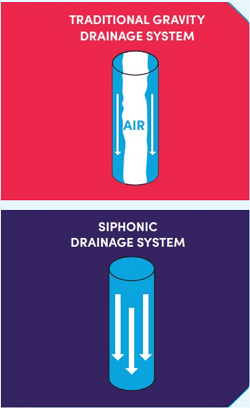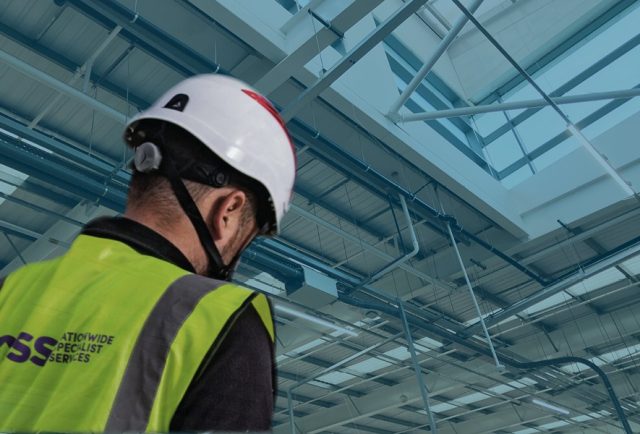Efficient drainage is important in construction and architecture, ensuring that buildings remain safe and functional during rainfall. Proper drainage prevents water accumulation, which can cause structural damage and safety hazards.
Two predominant methods for managing water drainage include gravity drainage and siphonic drainage.
So, what is the difference between gravity and siphonic drainage? Here’s a comparison of these two methods.
Basic Principles of Gravity Drainage and Siphonic Drainage
Gravity drainage is the traditional method of water removal. It relies on a downward slope and gravity to move water away from surfaces. This system uses large-diameter pipes that are installed at a gradient to ensure water flows naturally toward the drainage outlets.
Common applications for gravity drainage include residential buildings, smaller commercial buildings, and landscapes. Most configurations require multiple downspouts and extensive underground pipe networks to manage water effectively.
Siphonic drainage operates on the principle of creating a siphon effect to pull water from the roof. This system uses outlets and pipes to create negative pressure, allowing water to flow through pipes at high speeds.
Siphonic systems do not rely on gravity alone. They ensure an airtight seal to maintain the siphon effect. They are often used in large commercial buildings, stadiums, and areas prone to heavy rainfall.
Gravity vs Siphonic Drainage: A Comparison
Siphonic drainage systems stand out in terms of efficiency. Compared to gravity systems, they can remove water more quickly and in larger volumes, thus dealing more effectively with heavy rainfall.
The full-bore flow mechanisms of siphonic drainage systems ensure that pipes are air-tight and fully utilised, reducing the risk of blockages and overflow.
Siphonic systems offer more efficient drainage but require more complex installation procedures.

Advantages and Disadvantages of Both Systems
Gravity Drainage
Pros:
- Simple design and installation
- Effective for smaller buildings
- Lower initial engineering requirements
Cons:
- Larger pipe diameters needed
- Less efficient during heavy rainfall
Siphonic Drainage
Pros:
- High efficiency and capacity
- Flexible pipe routing
- Space-saving design
- Eliminates vortex effect from downpipes
- Has NO fall and is installed totally horizontal
Cons:
- More complex installation
- Requires precise engineering
- Potential higher initial costs
Suitable Applications
Gravity drainage is most commonly used in residential buildings, smaller commercial properties, and areas with moderate rainfall. Its simplicity makes it suitable for projects where space and slope are not constraints.
On the other hand, siphonic drainage is best suited for large commercial buildings, stadiums, and regions experiencing frequent, heavy rainfall. Its high efficiency, capacity, and flexible design make it ideal for complex and densely built environments.
Conclusion
Understanding the differences between gravity and siphonic drainage systems is important for selecting the right solution for your project.
Gravity drainage offers simplicity and cost-effectiveness for smaller projects, whereas siphonic drainage provides superior efficiency and flexibility.
Where can I go for further information?
Check out our quick guide to siphonic drainage for more on how siphonic drainage works, the key benefits, and critical calculations to ensure your system is fit for purpose.

